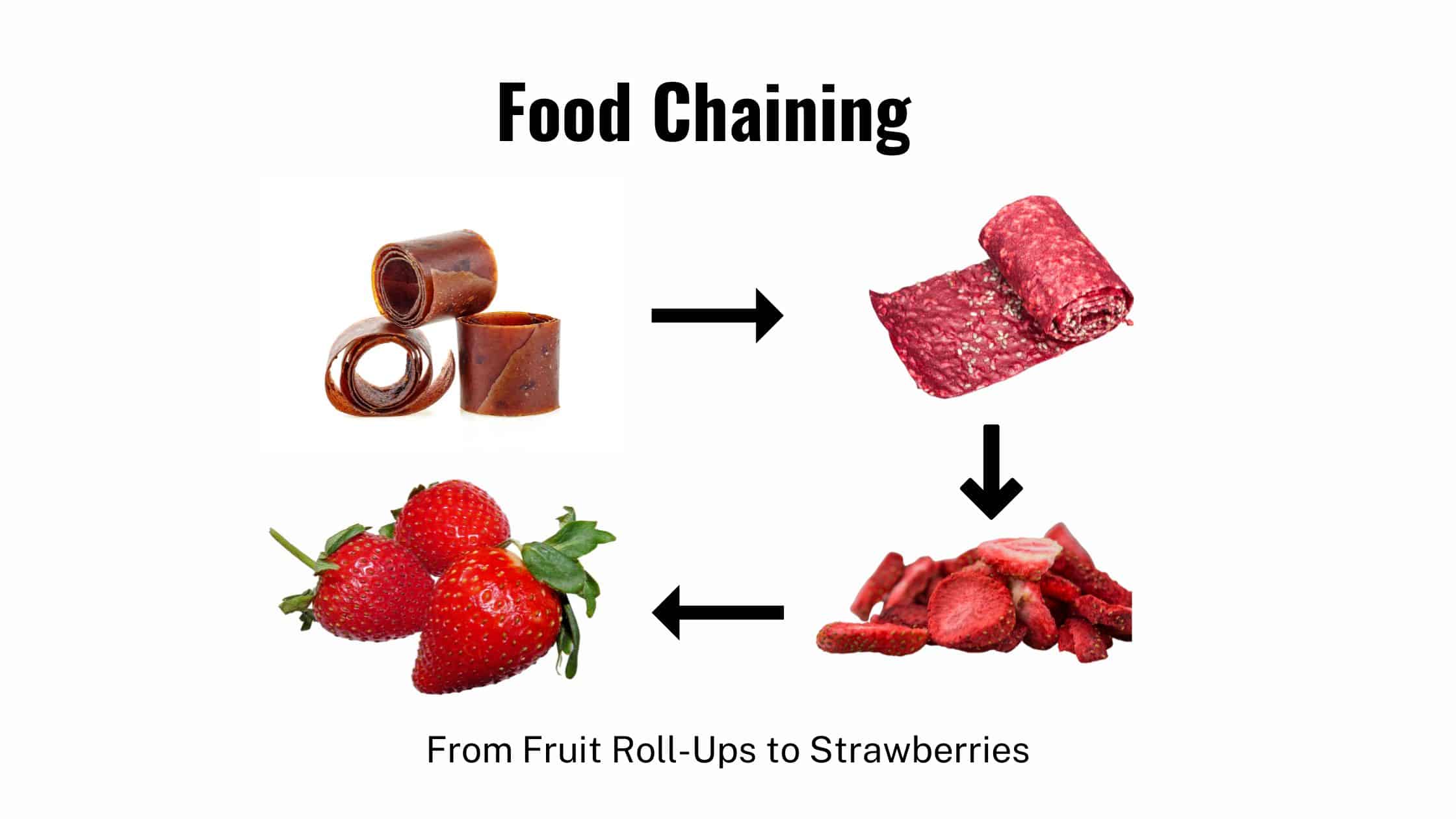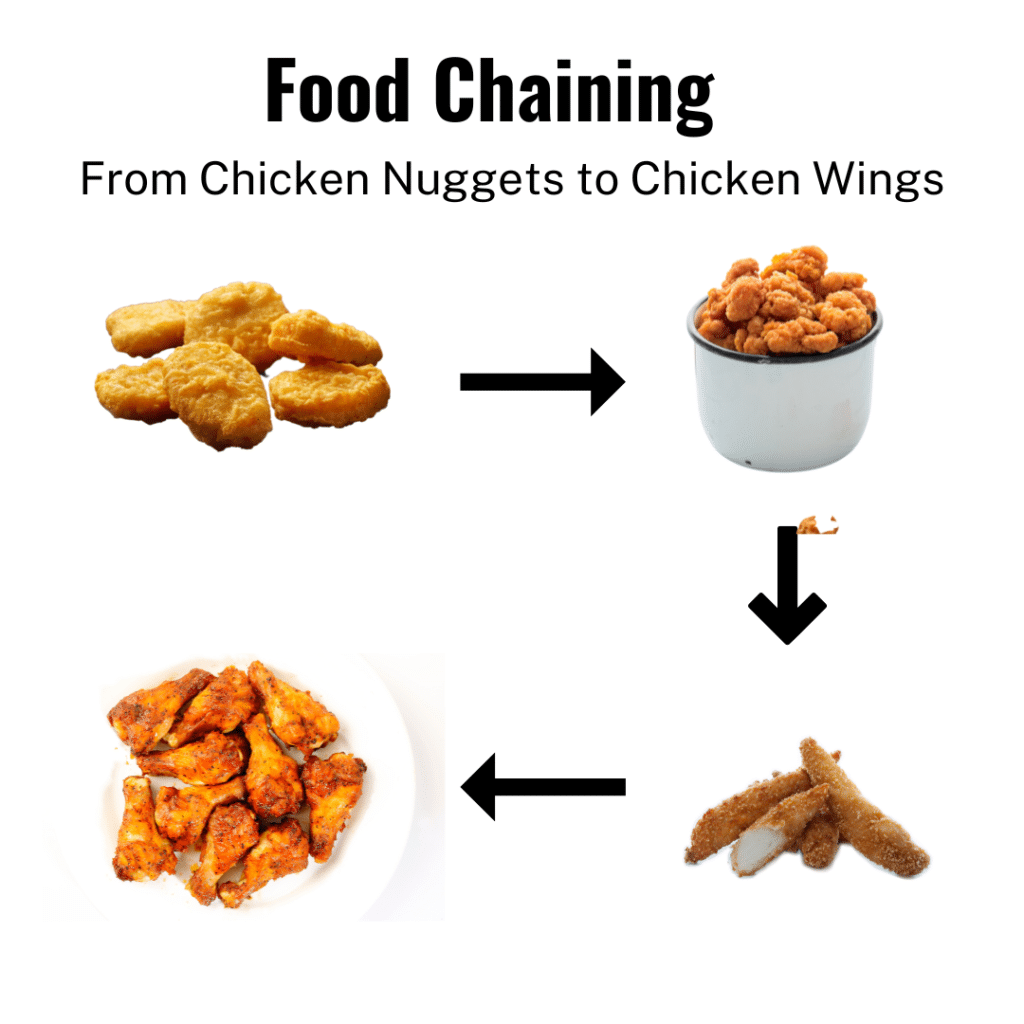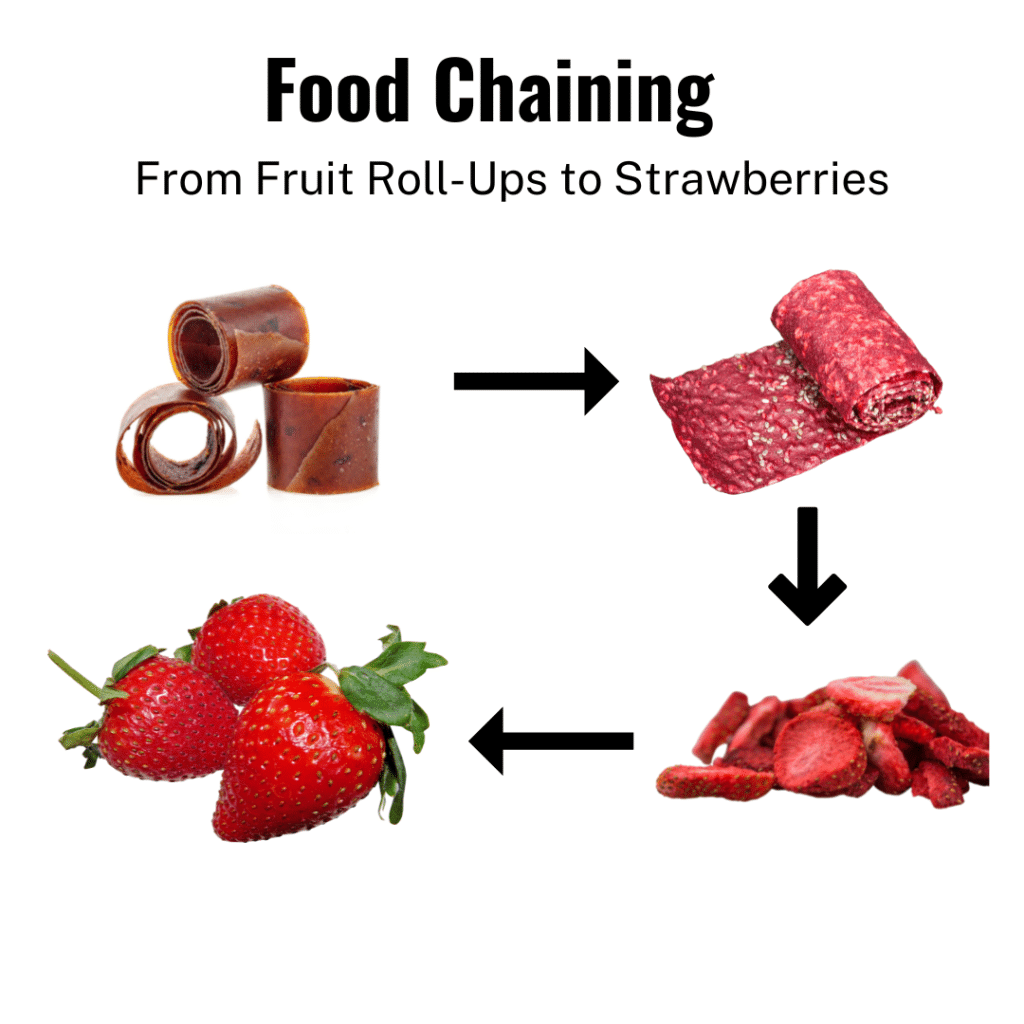
How Food Chaining Therapy Works: A Solution for Picky Eaters with Examples
How can you break the frustrating mealtime cycle with a picky eater? Food Chaining is a method of feeding therapy that introduces new foods, building off of foods they already like. In this blog, our dietitian breaks down how it all works.
Dinnertime! Your child comes to the table and refuses to eat what you’re offering. Again. So you take some chicken fingers out of the freezer, just so she eats something. Again…
I get it! For years, my daughter refused to try new foods too. We spent so many nights at the table struggling to get her to eat anything! I felt like a total failure as both a mom and a dietitian.
Today, she is a healthy, adventurous eater, I’m confident she gets the nutrients she needs, and we’re all more relaxed at mealtime. I want to help you enjoy time at the table with your family, release the worry, and take your child from picky to peaceful. Food Chaining might help you do this!
What is food chaining for picky eaters?
Food chaining is a method of introducing new foods to picky eaters, building off of foods they already eat. It was created by two Speech-Language Pathologists, Cheri Fraker & Laura Walbert.
Food Chaining is based on the child’s preferences for texture, taste, temperature, colour or appearance of foods. And these preferences are used to introduce new foods that are similar in one or more of these properties.
Food Chaining is a home-based feeding therapy program, often guided by a healthcare professional or feeding therapist with training. Parents are provided with food choices to offer the child. They then analyze the child’s response to the new foods and alter the food or chain as required.
Who is food chaining for?
Food chaining can be used for children with autism, developmental delays, neurodiversity, Pediatric Feeding Disorder, sensory sensitivity or typically a developing child. And even adults!
Food Chaining works even better with older compared to younger children. Children about ages six and up can help you create a food chain. And you can use cognitive bridges easier to show similarities between foods. “This zucchini is the main ingredient in your favourite zucchini bread!”
The research behind food chaining
Some research shows Food Chaining works to expand the diet. A study of 10 kids aged 1 to 14 with extreme food selectivity practiced food chaining for three months at home. They practice for 0.5 to 2 hours per week with therapy sessions provided in person, via video, email or telephone.
The number of accepted foods was recorded at the start of the study and the end of the three months. The accepted foods initially ranged from 1 to 8 and then, after three months, ranged from 8 to 129. Food chaining led to an increased variety of food for all participants.
Food chaining rules
Before I share how to start food chaining, there are a few points to keep in mind.
1) There is no pressure to eat. Don’t say: “Take a bite.”
2) You can describe the sensory properties of the food like: “This feels squishy.” Your child will learn this language, which helps them predict how the food will feel.
Remember the sensory hierarchy: your child may need to get comfortable even looking at the food first. They likely won’t jump right to eating the first time food is offered. First, they may want to get comfortable and interact with the food (i.e. “Can you hand that to mom?”). Then perhaps they will poke or touch the new food. Then smell, then taste and finally eat it!
3) We can model playing or eating the food but don’t impose on your child’s space. Self-feeding is expected.
“Once I put food in front of them, it belongs to them. I don’t try to force them, and I never say, ‘Take a bite.’ I model, and I let them feel that control and trust because that is absolutely key. I have expectations for them, and they know that, but I don’t let it become a battle. I always try to leave on a success.” – Cheri Fraker CCP/SLP, CLC.
4) Have low expectations and start with small portions. It’s not a quick fix. Unfortunately, nothing is!
Food Chaining Strategy: Before Starting Food Chaining Therapy
1) The Why
The first chapters of the Food Chaining book and course recommend dealing with “why” your child is a picky eater first. From breathing struggles, reflux, allergies, oral motor, and sensory sensitivities to family meal dynamics.
There are lots of reasons for picky eating beyond just behavioural. If you suspect an underlying reason for picky eating, talk to your medical professional or get a referral to a specialist.
2) “The Two-Week Cool Down”
This time is for your family to put energy into stopping stress so the child doesn’t fear coming to the table, basically, following the division of responsibility. You choose which foods are offered when and where. And your child chooses if or how much they eat (no pressure!!)
3) Diet analysis
This step is best done with your dietitian (ahem – me!). I look at whether your child’s current diet is balanced. Maybe we need to add a supplement or two to ensure they get certain nutrients while we learn to try new foods.
After looking at the accepted foods and diet analysis, we can develop some goal foods together. Perhaps this is a food your child wants to eat. Or maybe it’s a food from a food group he doesn’t eat at all now so that it would fill nutrient gaps.
4) List of accepted foods
A healthcare professional often does this food audit, and breaks accepted foods into different food groups. Be specific with brands and all details you provide. For example, if your child only eats chicken nuggets from McD’s, put “chicken nuggets but only from McDs.”
5) Flavour mapping
Flavour mapping looks at that list of accepted foods and compares properties. What flavour families does your child prefer: sweet, salty, sour, or spicy? Do they like strong or mild foods?
And texture: Do they like crunchy, chewy or soft foods? What about hot or cold foods?
If there are some dips or spices on that list, they can be added to a food chain too! This is called a “flavour mask.” Masking increases acceptance of new foods by allowing the child to experience a familiar taste paired with a new food item.
For example, Ranch Dressing is great for fries, vegetables, and meats. Ketchup or BBQ sauce work too. Chocolate fondu is a good flavour mask for fruits and crackers. You could use a seasoning like Mrs. Dash for savoury flavouring, cinnamon spice, or sugar for a sweeter food mask.
6) Food Chain Creation
After looking at the accepted foods list, our flavour map and goal foods. This is the fun part and where we create the treatment plan and food chains.
We get to brainstorm foods similar to foods the child likes. New foods are linked or similar to preferred food.
If your child is very cautious, perhaps we start with just their favourite food cut differently. Or cooked using a new method. Or offering different brands of that food.
Here are a few ideas that might help create a food chain, depending on your child’s preferences:
Similar sensory foods to add to a food chain
If your child likes crunchy foods, try
- nuts or seeds
- roasted chickpeas
- cracker sandwich
- rice cracker
- iceberg lettuce
- taco shell or taco chips with dips
- celery with nut butter
- parmesan cheese crisps
- crispy bacon
- sugar snap peas
- jicama
- freeze-dried fruit or veggie
If your child likes soft foods, try:
- yogurt, cottage cheese or laughing cow cheese
- baked apple or pear
- applesauce or pudding cup or Jell-O
- tofu (add silken tofu to smoothies)
- banana or zucchini muffin or bread with a spread
- scrambled eggs
- avocado, nectarine, banana or ripe melon
- pancakes (can make into a sandwich)
- potato wedges or mashed potato
If your child likes chewy foods, try:
- bagels
- dried fruit
- beef jerky
- muesli bar
- yogurt-covered granola bar
- cooked mushrooms
- fruit leather
- steak
- pepperoni stick
- grilled halloumi cheese or squeaker cheese
- gummy candy or licorice
If your child likes cold foods, try:
- frozen peas or corn
- frozen berries or fruit
- frozen yogurt tubs or “dots” or yogurt bark
- defrosting waffles or pancakes
- frozen smoothie or popsicle
- banana “ice cream.”
- fruit dipped in yogurt or nut butter and frozen
If your child likes sweet foods, try:
- chocolate fondu
- Nutella
- energy balls
- dried fruit or fruit leather
- chocolate milk
- chocolate covered nuts
- yogurt covered raisins
- fruit dipped in yogurt (can freeze)
- pancake with jam or syrup
- raisin toast
- nut butter mixed with yogurt & cinnamon as a dip
If your child likes salty foods, try:
- pickled vegetables
- deli meat
- salted nuts
- crackers
- salted kale chips
- olives or tapenade
- pretzels (dip them)
- dried seaweed
- soy sauce (as a dip)
- salt or Mrs. Dash’s (as a flavour mask)
- cheese (can also use as a flavour mask)
If your child likes sour foods, try:
- green apples
- lemons, grapefruit, rhubarb, cranberries
- yogurt, sour cream, kefir, kombucha
- vinegars as a dip or sauce
If your child likes spicy foods, try:
- pickled vegetables with chilli peppers or jalapenos
- spicy nuts or crackers
- baked chickpeas with cayenne
- popcorn with curry powder
- add hot sauce to foods
How to progress with food chaining therapy
Now you have your food chain, what do you do?
Offer a portion of food in the chain every day or two. You may have to offer this new food many times. If it’s refused 10-25 times, consider how to modify the food or choose a different one.
Offer transitional foods
Serve the new food along with a favourite food. The authors of Food Chaining call this a transitional food. Simply offer a preferred food between bites of new food. This helps to mask the aftertaste of the new food.
Use a rating scale & modify it as needed.
Ratings of reactions to new foods monitor progress
The dietitian or health care provider guiding you will need the rating scale every time a food is introduced. This helps us determine which foods to introduce next or how to modify the chain.
The food chaining program provides detailed descriptions of reactions and ratings from zero to ten. You could use a simpler 1 = gross, and 10= love it.
If a food is really disliked (rated less than 4), we can skip it. Or figure out how to modify it to be easier to eat. Can you cook it differently, cut it differently, or add food colouring? Add a dip or masking food?
Food Chaining Examples
Chicken Nuggets to Chicken Wings
- If your child likes chicken nuggets from Mcdonald’s, you can try offering popcorn chicken. Very similar flavour, texture, and colour, just a different shape!
- If this would be too big, try offering chicken nuggets from other restaurants or brands first.
- Once the popcorn chicken is accepted, move on to a different shape: chicken fingers! Again, you can try different brands or homemade if your child needs more steps in his chain.
- Then you could try breaded chicken wings. Then maybe non-breaded chicken wings.
- And move to different chicken products from there, like chicken legs and chicken breast.
- If your child likes a dip to mask during any or all of the steps, that’s fine!
Fruit Roll-ups to Strawberries
- If your child loves strawberry fruit roll-ups, we can create a chain from this. Our goal may be fresh strawberries.
- Starting with fruit roll-ups, we could offer strawberry fruit leather. It’s the same colour, similar flavour and just slightly different texture. You can try store-bought fruit leathers and/or homemade ones.
- Once the fruit leather is accepted, you could offer freeze-dried strawberries. Freeze-dried with a crunchy texture is easier to accept than fresh fruit. It’s a similar colour and taste to the fruit leather but a different texture.
- Then you could offer fresh strawberries.
- And if you want to continue, why not try strawberry yogurt or smoothies if these are new foods.
While food chaining isn’t a quick fix for your picky eater, it can work to expand your child’s food preferences. No more backup chicken fingers at dinner? This dream can be a reality!
For more examples of food chaining, check out my “Picky Eater Action Plan: How to use nuggets & fries to teach your kids to try new foods.”
Founder of First Step Nutrition | Registered Dietitian Nutritionist
Jen believes raising happy, well-nourished eaters who have a healthy relationship with food doesn't have to be a battle! She is an author and speaker with 18 years of experience specializing in family nutrition and helps parents teach their kids to try new foods without yelling, tricking, or bribing.








No Comments